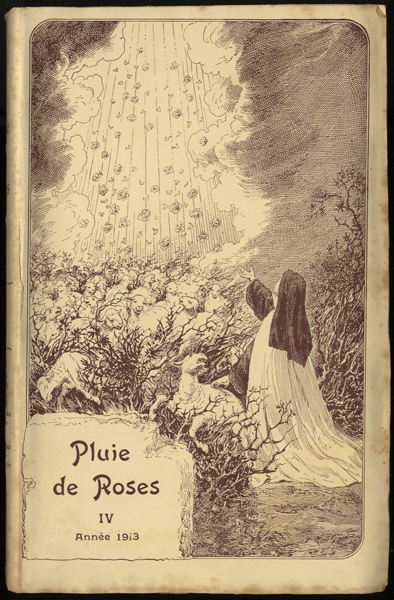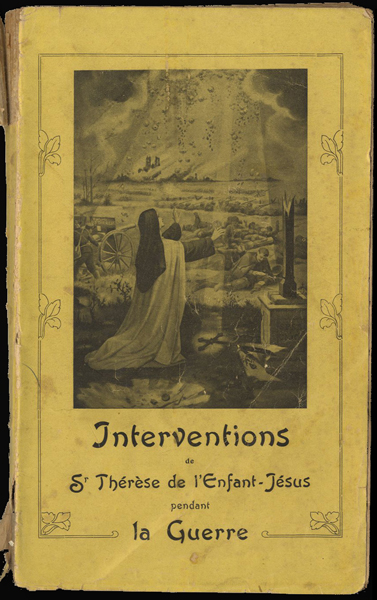Analysis of Rain of Roses covers between earth and sky: the place of Sister Thérèse
To look successively at the covers of the different volumes of the Rain of Roses is to follow step by step the posthumous story of Sister Thérèse, as understood by the Carmelites of Lisieux. The drawings are due to the joint work of Sister Geneviève and Charles Jouvenot, the main illustrator of all Carmel productions, always attentive to Sister Geneviève's instructions.







• Volumes I and II : The cover illustration of the first two volumes of the Rain of Roses is identical: on a cream cover, a sepia drawing representing rose petals falling on the terrestrial globe. Each petal bears an inscription: trust in God, spirit of sacrifice, resignation, good death, gentleness, conversion, chastity, abandonment, faith, peace, healing, love of God, zeal, protection, hope, fraternal charity... Healing is only one element among the diversity of spiritual graces.
• On the cover of the volume III, it is no longer a rain of rose petals that is offered to the reader, but a real rain of roses, in avalanche, through a clearing in the threatening sky, while we can read in epigraph: "I will fall a torrent of roses”; the increase in intensity is commensurate with the size of the volume: it is a book of more than 500 pages, and no longer a booklet.
• Coverage of volume IV is more dramatic than the previous ones: the Carmelite woman from behind, kneeling, stretches out her hand towards the cloudy sky which, classically, opens in the middle to let down on the earth, in a bright light, a shower of roses. This rain pours down on a flock of sheep caught in thornbushes and bleating skyward for deliverance. Sister Thérèse, in a gesture of compassion or protection, holds against her with her left hand one of these lost sheep, and extends her right arm towards the sky. Note that if the portrait of Sister Thérèse appears on the frontispiece of each volume, we have here the first figuration of the posthumous action of Sister Thérèse. The previous illustrations featured graces falling from the sky, here Sister Thérèse is presented both as an intermediary and as a protector; the environment is more threatening, the presence is more sensitive: we are on the eve of the first world conflict, international relations, while we fear, in France, a hardening of religious policy. But 1914 is also the year of the introduction of the Cause, signed on June 10 by Pius X. This decisive step in the canonization gives greater legitimacy to Sister Thérèse. Nevertheless, she is depicted from behind and on earth: the Church has not yet recognized her apotheosis, she cannot be the object of a cult, she cannot be depicted as a medal or a statue.
• Volume V: Since Rome agreed to open the process of canonization of Thérèse (June 1914), the publication of the Rain of Roses has been suspended. During the War, the Carmelites of Lisieux and the friends of Sister Thérèse felt all the more cruelly deprived of their miraculous annals as they perceived that, in this upset context, devotion to Thérèse took on a new form and scope. The cover of volume V, which makes up for the years of silence, effectively announces the return of the Rain of Roses. If the center of the cover takes up the theme of the previous volumes (the Rain of Roses pouring down on the earth and expressing the link between God and men), the whole, in its entirety, summarizes well the expectation of victory (with these years that go by from top to bottom, and bigger and bigger). At the corners, a scattering of Legions of Honor and other military distinctions reminds insiders of the ex-votos that flocked to Lisieux at that time. They also effectively evoke the role of individual courage in victory. In the coincidence of dates and the abundance of decorations awarded by their recipients to Thérèse, one can read the supernatural role awarded, in the immediate post-war period, to the “Patroness of the Poilus”.
• Interventions of Sister Thérèse of the Child Jesus during the War : this volume is an extract from volume V, published at the same time. Thérèse on the ground, on her knees, imploring, turning her back to the men like the priest at the altar: this attitude is reused for the cover of Interventions by Sister Thérèse of the Child Jesus during the war, where Thérèse is depicted on the battlefield. This illustration enjoyed great success during the war, during which it served as the basis for a number of propaganda publications, including a booklet of "letters" (i.e. accounts of miracles) published in 1915 and the back cover of the "little life". This illustration depicts a vision of the apocalypse: ground strewn with soldiers, burning cathedral, broken Calvary, dark and overcast sky... Sister Thérèse's hands seem to open the sky slightly so that the Rain of Roses can fall: it is well presented , within religion, as the one and only remedy.
• On the eve of her beatification, Sister Thérèse finally leaves earth to dwell in heaven: the cover of the volume VI figure the apotheosis; it reproduces the painting produced by Sister Geneviève for the ceremonies organized at the Vatican during the beatification: Blessed Thérèse, on a cloud, at the feet of a crowned Virgin and Child, takes roses from the knees of the mother and child to drop them on Saint Peter in Rome. From now on, she is no longer on the side of those praying, she is the one who brings down the Rain of Roses.
• With the canonization, a new step was taken, since Jouvenot painted, for the last Rain of Roses - volume VII - the gates of heaven opened by a little angel so that an avalanche of roses pours out. Saint Thérèse has disappeared from the eyes of the faithful, she is in the Holy of Holies. It is his consecration that is put forward, as well as the doctrine of spiritual childhood. The portrait of Sister Thérèse, full length and full face, is found as in previous editions on the frontispiece of the book. But it is no longer the portrait of Therese oval or Therese with roses, it is thehe portrait of the Canonization. We take a step forward in symbolism with a haloed Thérèse, shrouded in glory, surrounded by cherubim, resting on the ground in a completely virginal attitude. She lets her roses fall with her eyes raised to the sky, and on the banners held up by the angels, one can read "Deus Caritas est", and "I will return to earth to make love loved". The portrait is accompanied by the following quote: "I often think of all the good I would like to do after my death, to travel the earth in an instant to comfort those who mourn, to convert poor sinful souls, to have little children baptized, to help priests, missionaries, the whole Church. »
With this entry of Sister Thérèse into a Paradise adorned with the arms of Carmel, the publication in the annals of the great deeds of Saint Thérèse ends.
Antoinette Guise


